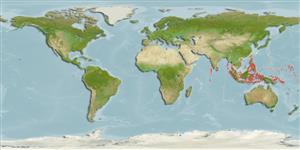>
Gobiiformes (Gobies) >
Gobiidae (Gobies) > Gobiinae
Etymology: Gladiogobius: Latin, gladius = sword + Latin, gobius = gudgeon (Ref. 45335).
More on author: Herre.
Environment: milieu / climate zone / depth range / distribution range
Écologie
marin; saumâtre récifal; profondeur 0 - 3 m (Ref. 90102). Tropical; 30°N - 9°S
Indo-Pacific: Red Sea to western New Guinea, north to the Yaeyamas in the southern Ryukyus; Palau in Micronesia.
Taille / Poids / Âge
Maturity: Lm ? range ? - ? cm
Max length : 7.5 cm SL mâle / non sexé; (Ref. 48637)
Description synthétique
Clés d'identification | Morphologie | Morphométrie
Épines dorsales (Total) : 7; Rayons mous dorsaux (Total) : 10; Épines anales: 1; Rayons mous anaux: 10. Large spine at lower posterior edge of preoperculum; characterized further by pale grey body color with narrow brown stripes and longitudinal rows of small white dots on side of body; lower side of body with row of five large rectangular brown blotches; irregular brown saddles along back; large grey spot above base of pectoral fin; elongate and filamentous fourth dorsal spine; rounded caudal fin; longitudinal scale series 23-25; head and nape without scales; ctenoid body scales except cycloid on abdomen, base of pectoral fin and prepelvic region; median predorsal scales absent; opening of gill not reaching to above edge of preopercle; moderately long cheek spine, 21-27% head length, not reaching posterior margin of opercular membrane; depth of body 4.8-5.4 in SL (Ref. 90102).
Inhabits tide pools of sandy intertidal areas of lagoons, bays, and river mouths. Also lives in sheltered sandy bays and estuaries among rubble and in lagoons along edges of coral patches. Usually found in small loose groups (Ref. 48637).
Life cycle and mating behavior
Maturities | Reproduction | Spawnings | Egg(s) | Fecundities | Larves
Myers, R.F., 1991. Micronesian reef fishes. Second Ed. Coral Graphics, Barrigada, Guam. 298 p. (Ref. 1602)
Statut dans la liste rouge de l'IUCN (Ref. 130435)
Menace pour l'homme
Harmless
Utilisations par l'homme
Pêcheries: sans intérêt
Outils
Articles particuliers
Télécharger en XML
Sources Internet
Estimates based on models
Preferred temperature (Ref.
123201): 28 - 29.4, mean 28.8 °C (based on 1165 cells).
Phylogenetic diversity index (Ref.
82804): PD
50 = 0.6250 [Uniqueness, from 0.5 = low to 2.0 = high].
Bayesian length-weight: a=0.01023 (0.00477 - 0.02194), b=3.02 (2.84 - 3.20), in cm total length, based on LWR estimates for this (Sub)family-body shape (Ref.
93245).
Niveau trophique (Ref.
69278): 3.3 ±0.4 se; based on size and trophs of closest relatives
Résilience (Ref.
120179): Haut, temps minimum de doublement de population inférieur à 15 mois (Preliminary K or Fecundity.).
Fishing Vulnerability (Ref.
59153): Low vulnerability (10 of 100).
